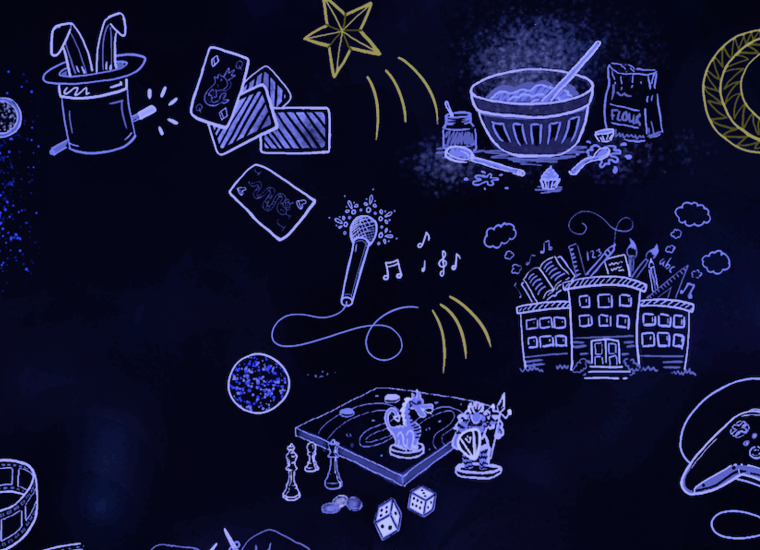When cultural organisations think about widening participation in arts and culture, they often mean improving access to their established offers. But, if we accept that well under half the population attends a performance or exhibition even once a year, we have to wonder what we can do for the other 60+% of the communities we serve? Could supporting people in their free-time pursuits - so-called ‘everyday creativity’ - be one answer?
We’ve recently been working with Arts Council England (ACE) to find out, with a practical resource exploring how to support more people to be everyday creatives, due to be published in the next few months.
Meanwhile, in contrast to cultural engagement with institutions, the Cultural Participation Monitor (CPM) tells us that 85% of the population say they do at least one type of creative activity on a regular basis.
The pandemic experience drove up these numbers – people who already had ‘creative hobbies’ said they did more, and there was an increase in the number of people who listed them as a ‘key interest’, a trend that skews towards younger people and has continued post-pandemic. Activities can be done alone or with friends and family, informally, at home or in more formal settings.
What is ‘everyday creativity’?
All these activities can come under the wide umbrella of everyday creativity. It’s a term adopted in recent years both to get away from the problematic – often patronising and simplistic – distinction between ‘amateur’ and ‘professional’ and to encourage a wider view of people’s creative lives. We think of it as anything any of us does that we might describe as creative for our own enjoyment or fulfilment.
It covers a dizzying range of activities – from visual arts and craft, performance, music and film-making, movement, writing, to gardening, cooking, creative gaming, reading, make-up, and scavenger-hunts, with new ones emerging all the time. Communities take shape in more or less formal ways, both:
- in-person, perhaps in a faith group, youth organisation, village hall, membership organisation, Cosplay group, book-club...
- and increasingly as a digital network, as likely hyper-local as global.
The demographic diversity of ‘everyday creatives’ changes across all these areas. Although lots of people have multiple hobbies – the most universal activities relating to food and nature – younger generations of course tend to have different interests from older ones. But stats suggest we shouldn’t be too quick to categorise.
Importantly, we discovered that many ‘amateur’ creatives are interested in earning from their activities, while lots of ‘professionals’ enjoy taking part just for fun.
Beyond ‘amateur’ vs ‘professional’
In 2015, leading – and inspirational – specialists, 64 Million Artists, Voluntary Arts (now Creative Lives) and Fun Palaces formed a grassroots coalition to champion the importance of everyday creativity within the cultural ecology.
Their research with cultural professionals led to an influential 2016 report which remains essential reading for anyone wanting to learn more, and was the starting point for our research. They talk about everyday creativity as the huge range of self-directed and self-organised activities that are not mediated by creative professionals or institutions.
In this sense, the participatory activities offered by many cultural organisations might fall outside this definition inasmuch they are devised and orchestrated by an institution. And while they inspire many people, there are many others who want to follow their own path, in fact the CPM shows that lots of everyday creatives don’t engage with cultural institutions with any kind of regularity. Do we have something to offer them too?
Give and gain: the role of the cultural sector
Our research brief was to ask what cultural organisations can actually offer people to support their own creative journeys. This seems particularly important at a moment in which organisations (and their funders) are reimagining what it is to be a cultural resource.
The answer for many is of course about creating with as well as for their community, which in turn means developing a much more nuanced understanding of everyday creativity and our relationship to it. Meanwhile, the public’s post-Covid appetite for creativity still seems to be growing, especially among younger generations. It’s an appetite reflected in – perhaps accelerated by – Strictly, Bake Off, Sewing Bee, Big Painting Challenge, Big Flower Fight… the list grows.
Our research also shows that organisations have as much to gain from working with everyday creatives as they have to give. We talked to organisations leading in the field – like Pendle’s In Situ – and heard how it helped their visibility, positioning and relationships and, more profoundly, had a generative effect on their staff and artist teams: “The ideas people started fed our own thinking.”
A different mindset: meeting people where they are
One of the most surprising findings, however, was how cultural organisations often get it wrong. We talked to individual everyday creatives as well as groups, from one-offs like Folk Around Fishponds, to largescale bodies like the Women’s Institute.
We heard of some uncomfortable experiences: people felt they had been patronised, their goodwill taken for granted, their opinions ignored, stories appropriated, and creativity dismissed. The overarching advice was to think about building a relationship first and then develop activities from a position of mutual understanding, rather than imposing or promoting pre-set ideas.
The phrase 'you have to meet people where they are' came up time and again. The groups we spoke to advocated having an open door, being visibly available and spending time just catching up with local organisers and chatting to interested participants in classes etc. 'No conversation is wasted' as the inspirational Eltham Library say.
What everyday creatives really want
It’s important to remember that people are often seeking the complex benefits of self-expression alongside the general enjoyment of taking part in social activities. You can delve deeper into these motivations in this digest from Centre for Cultural Value offering an overview of many studies, which forms part of our research.
This is a bit different to the pleasure we might get from professionally curated experiences and so it makes sense that everyday creatives don’t particularly look for expert-led projects, direction or training. Our research suggests they have four main areas of need:
- Validation: interest in, engagement with and feedback on their work, and opportunities to showcase and celebrate.
- Practical resources: spaces, materials, small grants with low admin, support with things like marketing and legal – for many people, just finding time is a major barrier.
- Connections: opportunities to join/form a community of peers, find collaborators and the social-creative benefits this brings.
- Navigation: advice on where to get help, what resources and networks are available to them that they might not already know about.
What can organisations do?
Everyday creatives do also say they appreciate the inspiration and ideas they get from engagement with arts programmes, museum collections etc. For many, the classes and workshops provided by libraries, writers centres, dance studios and many more organisations are essential to some people’s practice and the hub of their creative community.
But to connect with new and different everyday creatives, organisations would do well to tune into these four areas of need. Check out how everyday creativity champions like Fun Palaces or 64 Million Artists do it. They take a facilitative role – often creating a supportive framework in which people can take their own lead.
So, organisations need to ask: what assets can we offer? Not second guess what the everyday creatives on their doorstep require, but find out. Our interviewees encouraged making it personal – join a group yourself, chat to people. As an employer, find ways to support the everyday creatives in your organisation – like giving them time to pursue their own creative interests.
The three Rs of supporting everyday creativity
So, then, can supporting everyday creativity really help us to widen participation? The evidence suggests that it can – but only where organisations are willing and able to think more laterally about what their assets can contribute to the creativity of others.
If you’re looking for a starting point, we recommend adopting these three Rs:
- Relate: Meet people where they are. Get to know the community and what matters to them. Build relationships that are able to change and last over time.
- Respect: Give credit, offer encouragement and recognise what is valued. Respect people’s time, commitment and difference.
- Reciprocate: Think carefully and creatively about what you can give and what you can gain. Base relationships on mutual need by reviewing and renewing together.
ACE will be publishing the full Supporting Everyday Creativity resource in the coming months, so do sign up to our monthly newsletter if you’d like us to let you know when that becomes available.
This article was originally published in Arts Professional as part of a series sharing insights into the audiences for arts and culture.



